Dialogues and Questioning
To engage students in dialogue on art appreciation and criticism, teachers may use the six questioning strategies to guide students’ exploration of an artwork. As an example, we will apply the six question types to talk about Johannes Vermeer’s The Milkmaid. Go to Resources

The Milkmaid, c. 1657-58
Johannes Vermeer (1632 - 1675)
Oil on canvas
45.5 x 41 cm
Rijksmuseum, Amsterdam
Personal Connection Questions
Introduction
- Draw attention to viewers’ personal associations (e.g. personal experience, values, emotions) with an artwork.
- Consider the fundamental question: “How do I (as a viewer) engage in this aesthetic experience?”
- Elicit students’ personal responses to and reflection on an artwork.
- Ask students to reflect on how their own perceptions are changed after viewing an artwork.
- Arouse students’ curiosity and wonder about an artwork. Encourage students to relate the artwork to their personal experience in order to make sense of the artwork and build up confidence in engaging in artistic dialogue.
Examples
- What is your initial reaction to the artwork? Why?
- What comes to your mind when you first see the artwork? What makes you have such associations?
- Is there anything about the painting you want to know more about? Can you identify anything that interests you? Why?
- Have you ever performed chores in the kitchen? Can you identify any commonalities between the artwork and your daily life?
- Have your family hired a domestic helper? Have you observed how they perform domestic chores?
Student themselves, their family members or domestic helpers perform domestic chores at the kitchen.

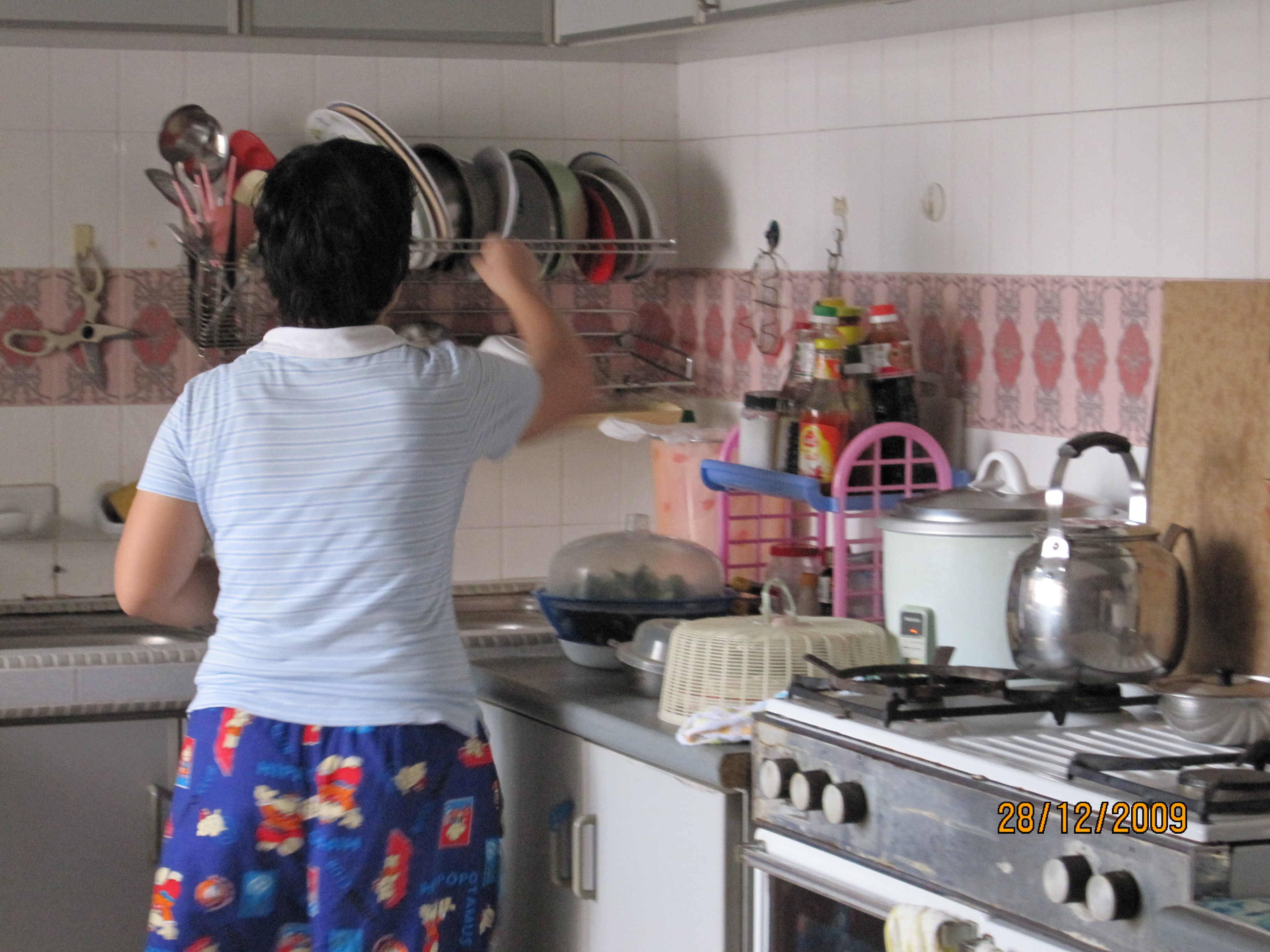
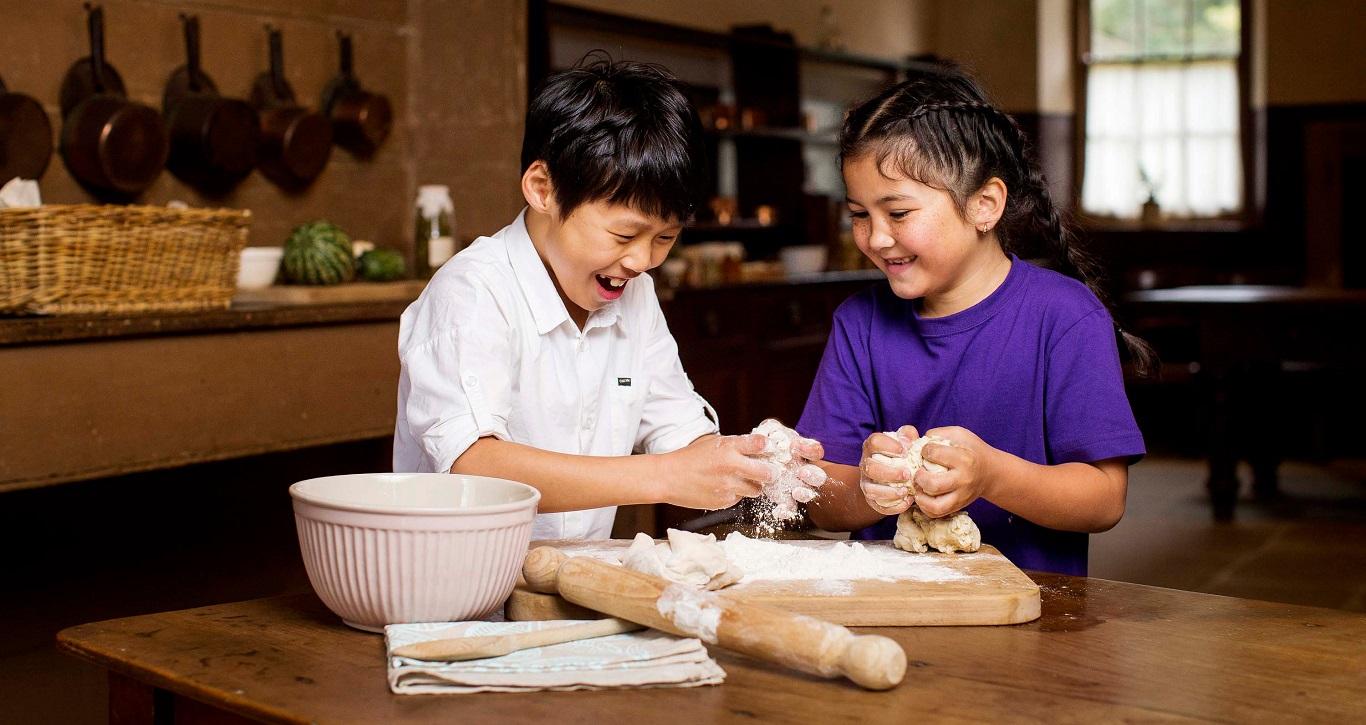
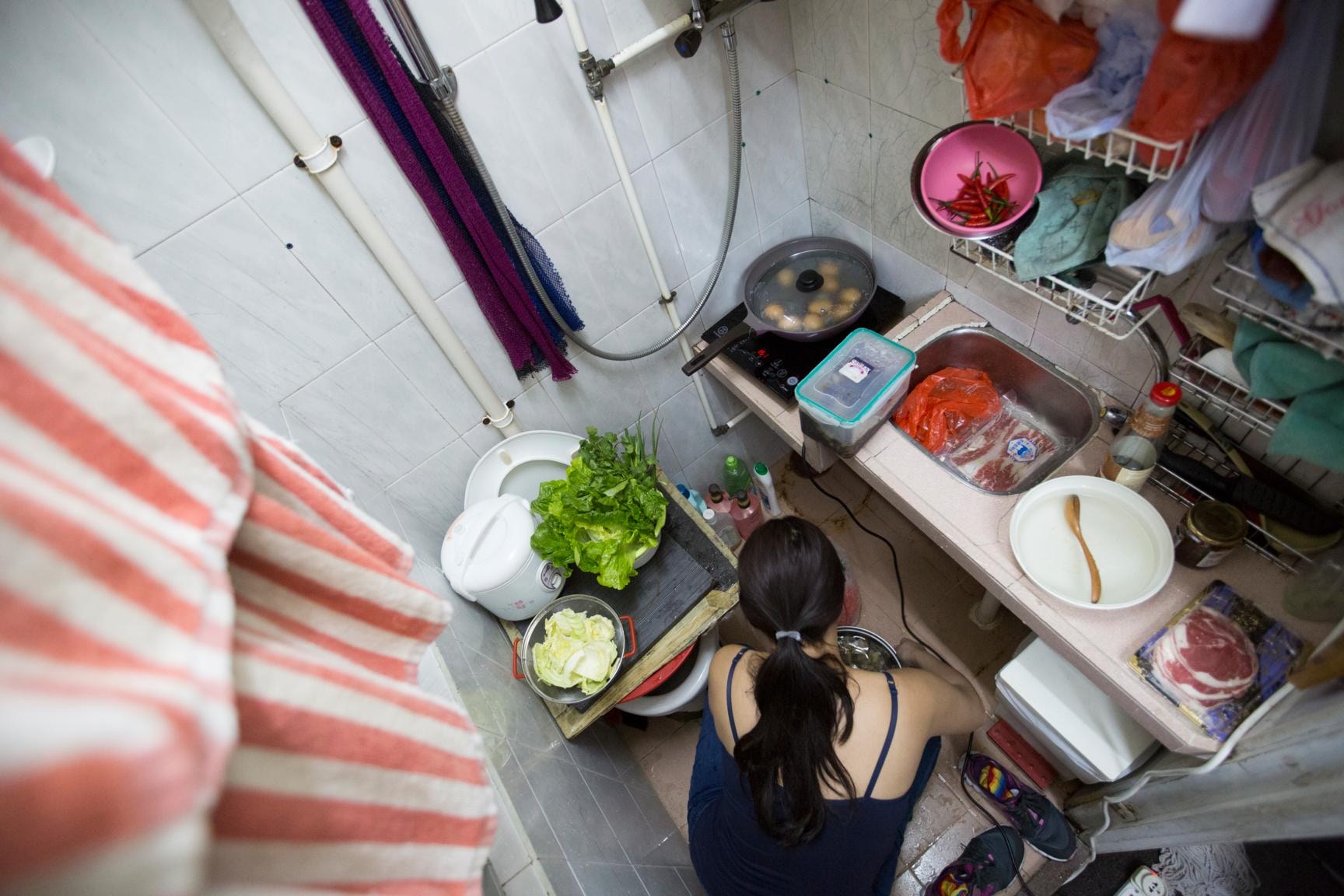
Actual size of the artwork and the environment exhibiting the artwork.




Vermeer’s works in the collection of the Rijksmuseum in Amsterdam.

The Little Street, c. 1658
Johannes Vermeer (1632 - 1675)
Oil on canvas
54.3 x 44 cm
Rijksmuseum, Amsterdam

The Milkmaid, c. 1660
Jan Vermeer (1632 - 1675)
Oil on canvas
45.5 x 41 cm
Rijksmuseum, Amsterdam

Woman Reading a Letter, c. 1663
Johannes Vermeer (1632 - 1675)
Oil on canvas
46.5 x 39 cm
Rijksmuseum, Amsterdam

The Love Letter, c. 1669 - c. 1670
Johannes Vermeer (1632 - 1675)
Oil on canvas
44 x 38.5 cm
Rijksmuseum, Amsterdam
Location of the artwork.

Rijksmuseum, Amsterdam



Observation Question
Introduction
- Consider the fundamental questions: “What is happening in the artwork? What can we observe in it?”
- Pay attention to the appearance of an artwork, the event(s) or the object(s) depicted in the artwork.
- Ask students to observe an artwork in detail and give a full description in class.
- Help students collect source materials, equipping them with background knowledge to make further analysis and interpretation.
- Make careful and comprehensive observations of an artwork, especially on the details of specific parts. Articulate the insights in verbal / written descriptions.
Examples
- What do you see in the artwork? Any figures, objects or events?
- Who is the woman at the center of the painting? What is she doing? How is she dressed?
- Is that an interior or exterior setting? How could you tell? Where is she?
- What are the objects on the table used for?
- Is there anything depicted in the painting you have never seen before? Do you know what is the small wooden box in the bottom right corner?
Vessels depicted in the painting.



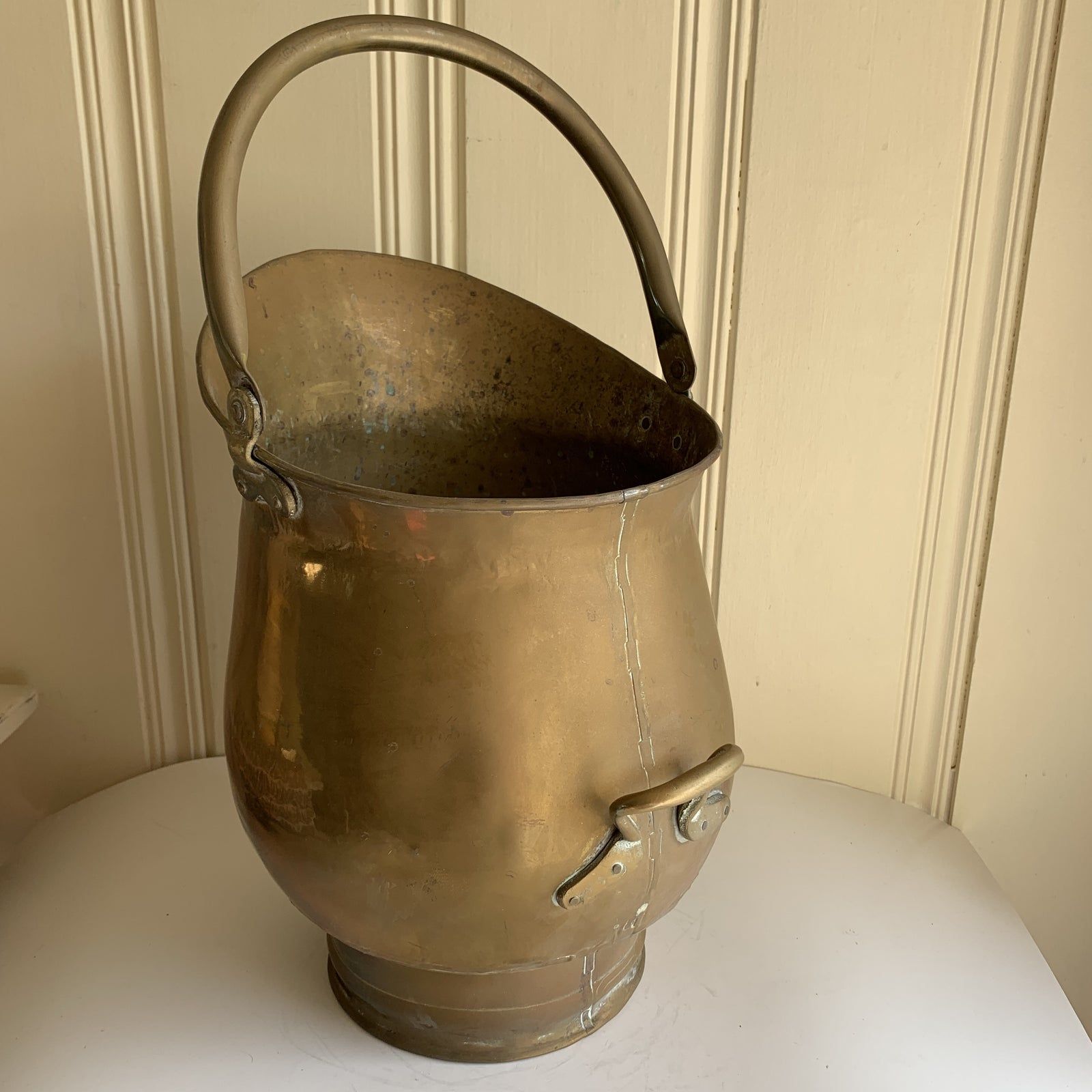
The maid is probably making bread pudding.




The small wooden box in the bottom right corner is a foot warmer.



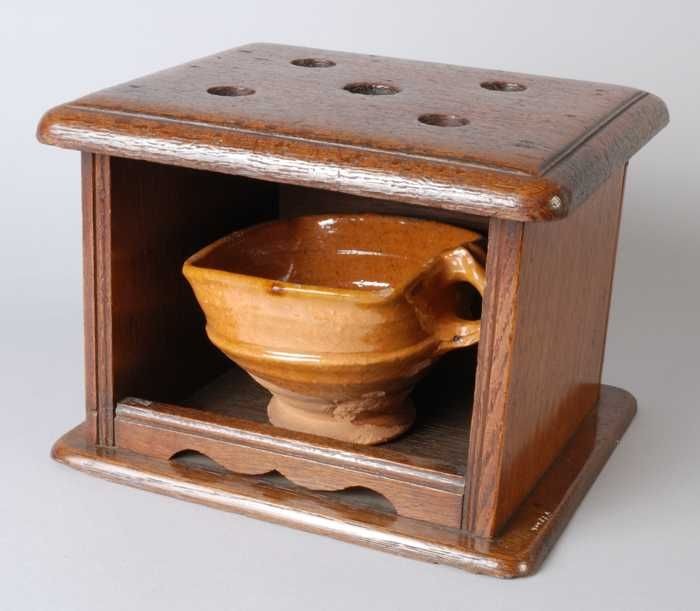
Paintings of Vermeer’s time depicting foot warmers.
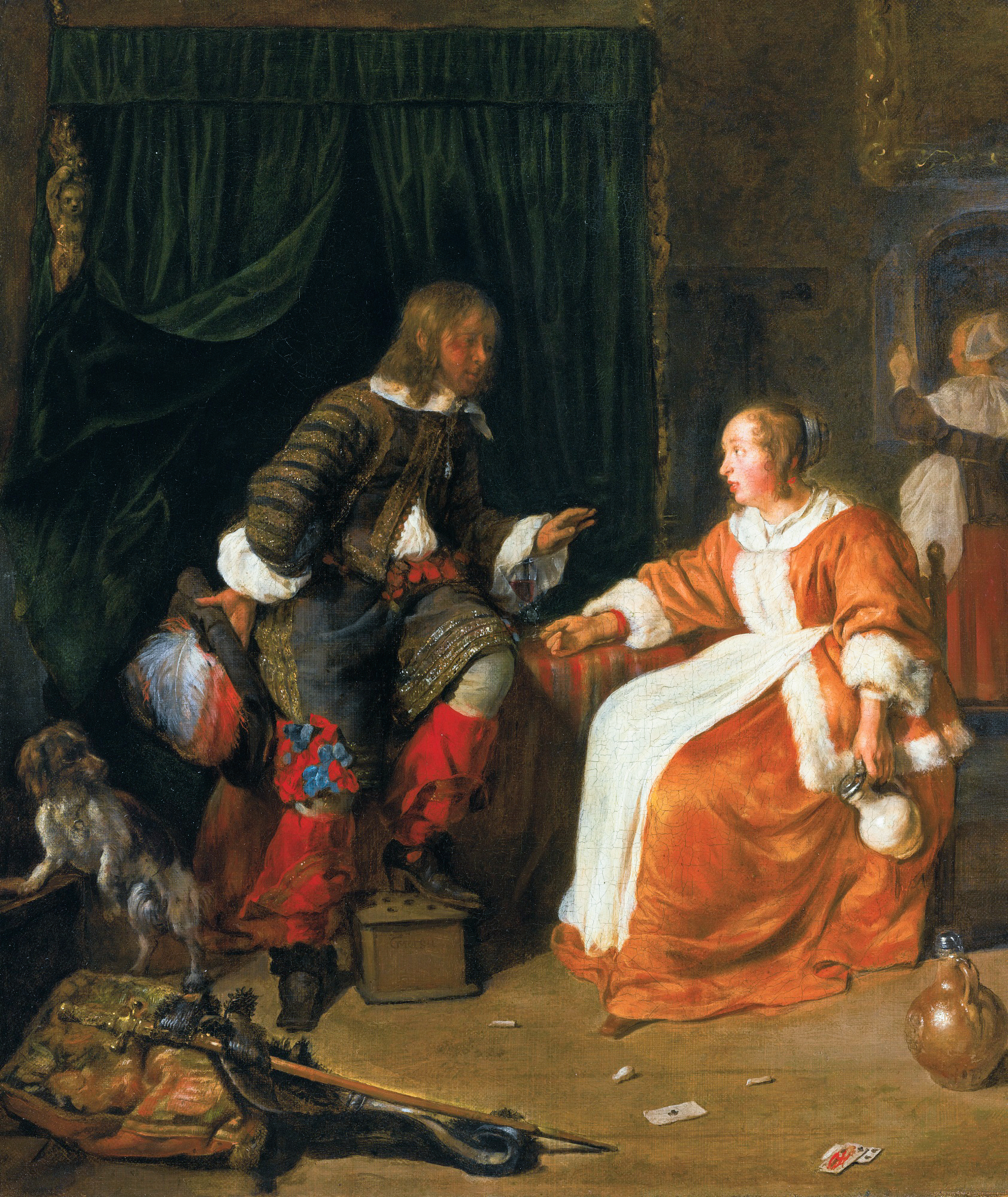
Woman Offering A Glass of Wine to A Man, 1659
Gabriël Metsu (1629 – 1667)
Oil on canvas
Private Collection
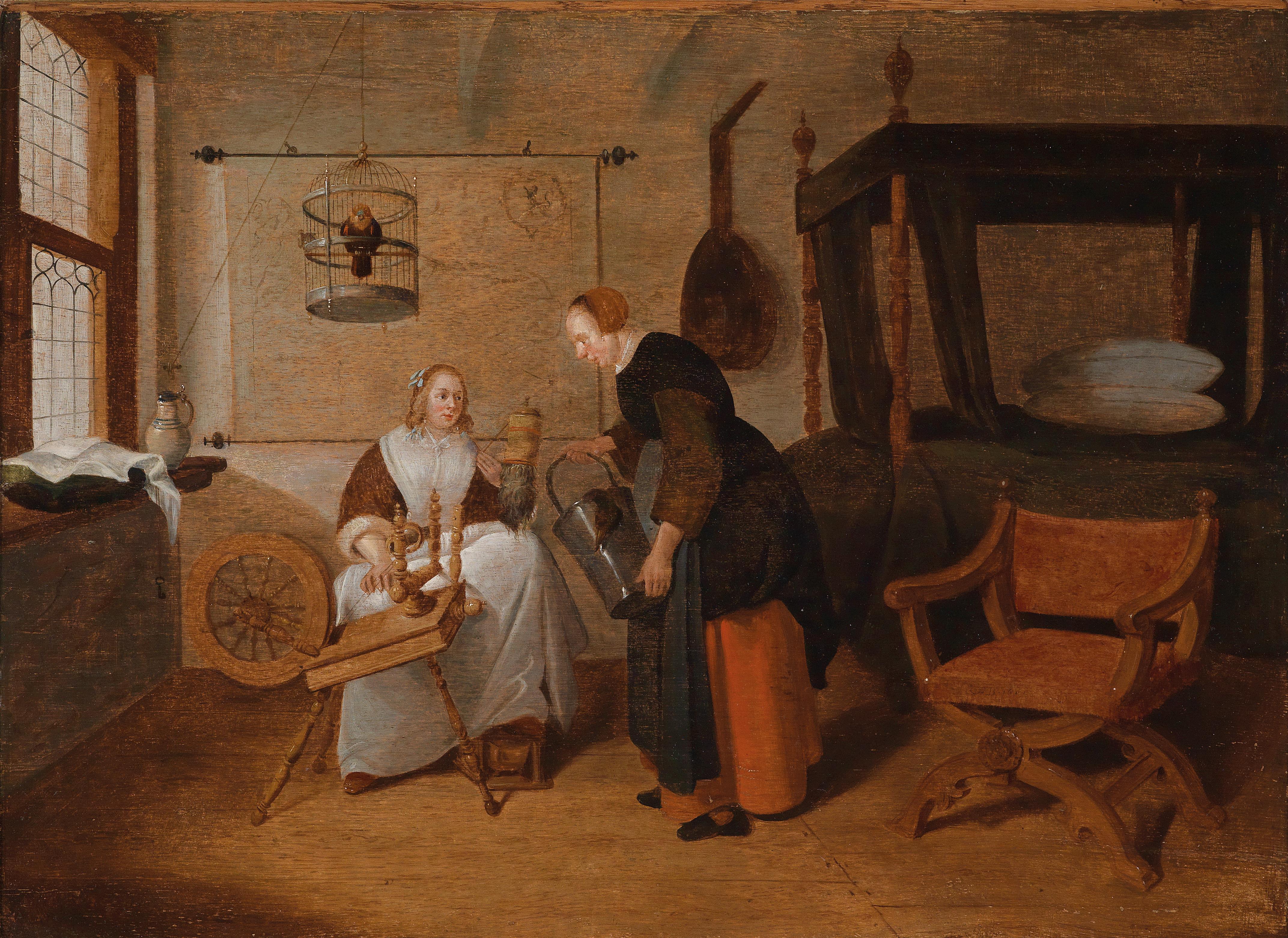
Young Woman And A Maid, 1661
Quirijn Gerritz van Brekelenkam, (1622 - 1668)
Oil on panel
49 x 66.5 cm
Manchester Art Gallery, Manchester

Interior With A Lady Choosing Fish, 1664
Quiringh Gerritz van Brekelenkam (1622 - 1668)
Oil on panel
49.8 x 39.4 cm
Manchester Art Gallery, Manchester
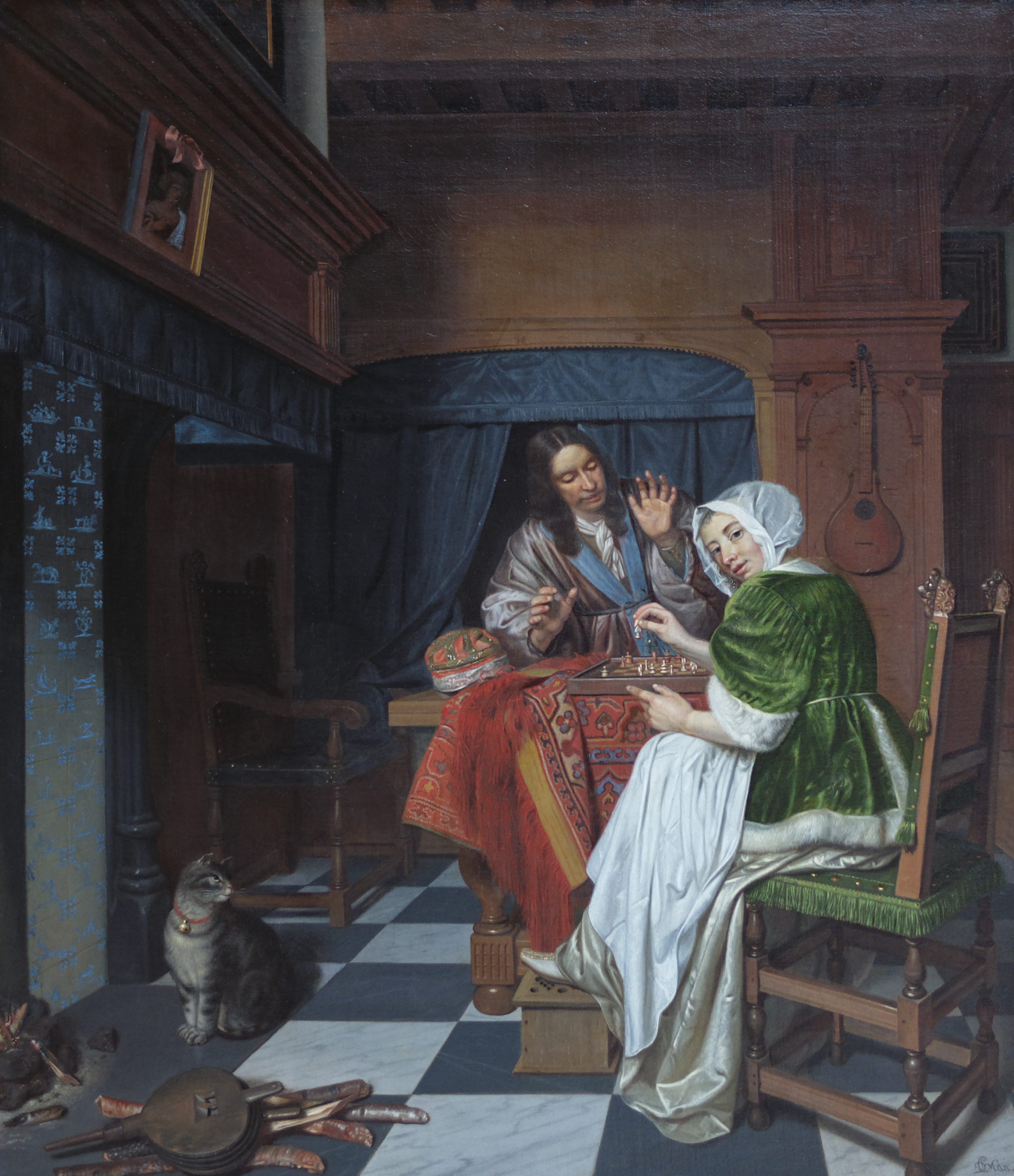
The Chess Players, c. 1670
Cornelis de Man (1621 - 1706)
Oil on canvas
97.5 x 85 cm
The Museum of Fine Arts, Budapest
A broken window in the painting.

Visual Analysis Question
Introduction
- Consider the artwork as an object and focus on the visual elements employed by the artist in the work.
- Pay attention to different objects depicted in the artwork and the relationships between individual parts, e.g. colour, shape, texture, creative process, proportion, scale, size, space, and time.
- Ask students to undertake visual analysis of the artwork.
- Engage students in considering the artwork from the perspective of aesthetics or forms.
- Discuss the artwork in terms of its creative approach, use of medium, how the work is organized and represented, and also relevant aesthetic concepts and perceptual skills.
Examples
- Do you like the colours of the maid’s clothes? Which part is rendered in the brightest colour? How is the arrangement of various colours?
- What is the facial expression of the maid? How is the texture of the appearance? What kinds of effects have been created?
- Which part of the painting do you find most attractive? Where is the focal point of the work? Why?
- Do you know the actual size of the artwork?
- How is the light in the interior setting? How is the tone of the wall?
Compared to other paintings of women by Vermeer, the facial texture of the maid in The Milkmaid looks rougher.

The Milkmaid, c. 1657-58 (detail)
Johannes Vermeer (1632 - 1675)
Oil on canvas
45.5 x 41 cm
Rijksmuseum, Amsterdam

Girl with a Pearl Earring, c. 1665 (detail)
Johannes Vermeer (1632 - 1675)
Oil on canvas
44.5 × 39 cm
Mauritshuis, The Hague

A Lady Writing, c. 1665 (detail)
Johannes Vermeer (1632 - 1675)
Oil on canvas
45 × 39.9 cm
National Gallery of Art, Washington, D.C.

Study of a Young Woman, c. 1665 - 1667 (detail)
Johannes Vermeer (1632 - 1675)
Oil on canvas
44.5 × 40 cm
Metropolitan Museum of Art, New York

The Art of Painting, 1666 - 1668 (detail)
Johannes Vermeer (1632 - 1675)
Oil on canvas
120 × 100 cm
Kunsthistorisches Museum, Vienna
Perspective, composition and focus of the artwork.

One-point perspective was employed in the artwork, with a nail hole placed in the position of the vanishing point, suggesting that Vermeer established the perspective by drawing intersecting lines.
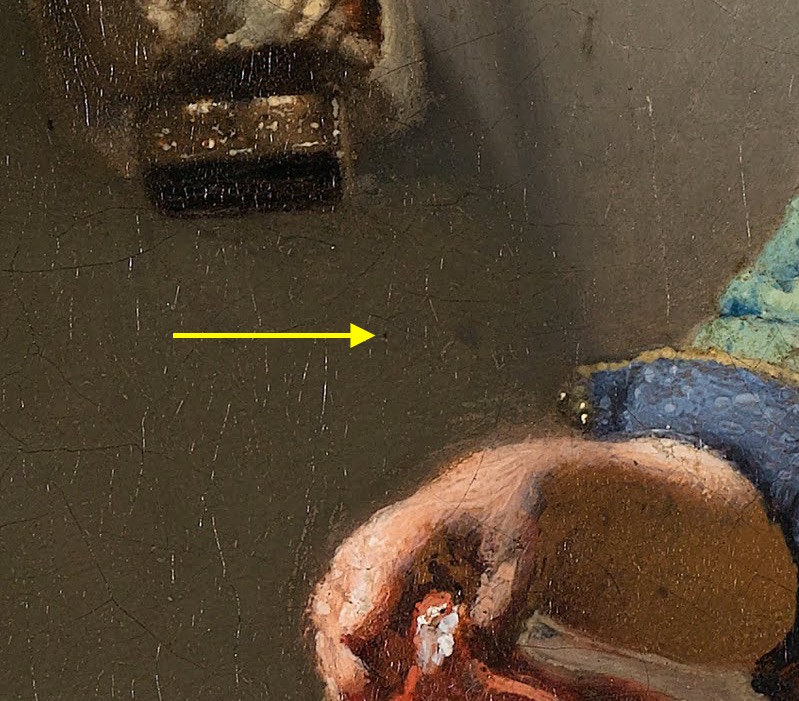
Trace of the nail hole.
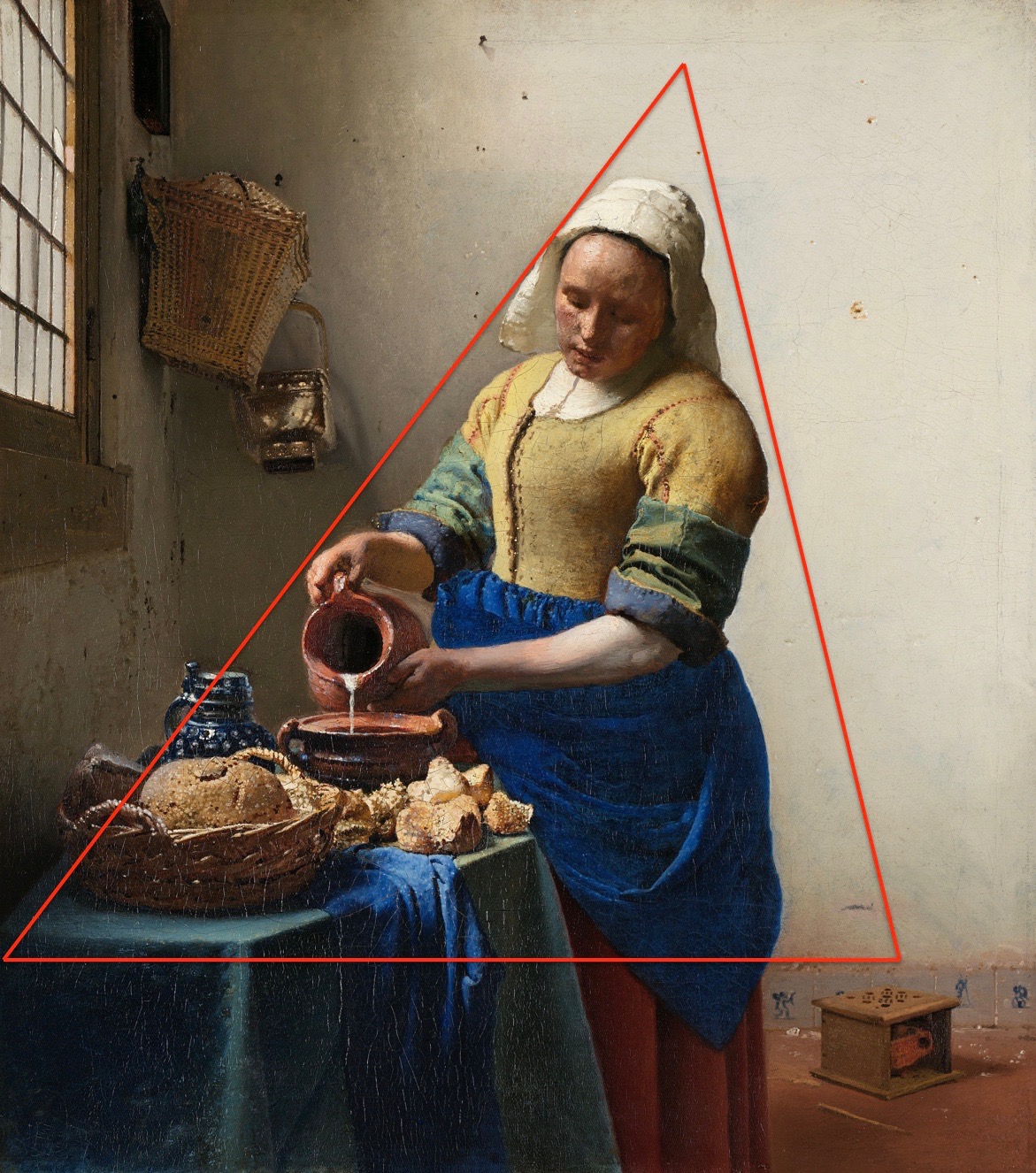
The milkmaid, the table and the food on the table form a pyramid composition.
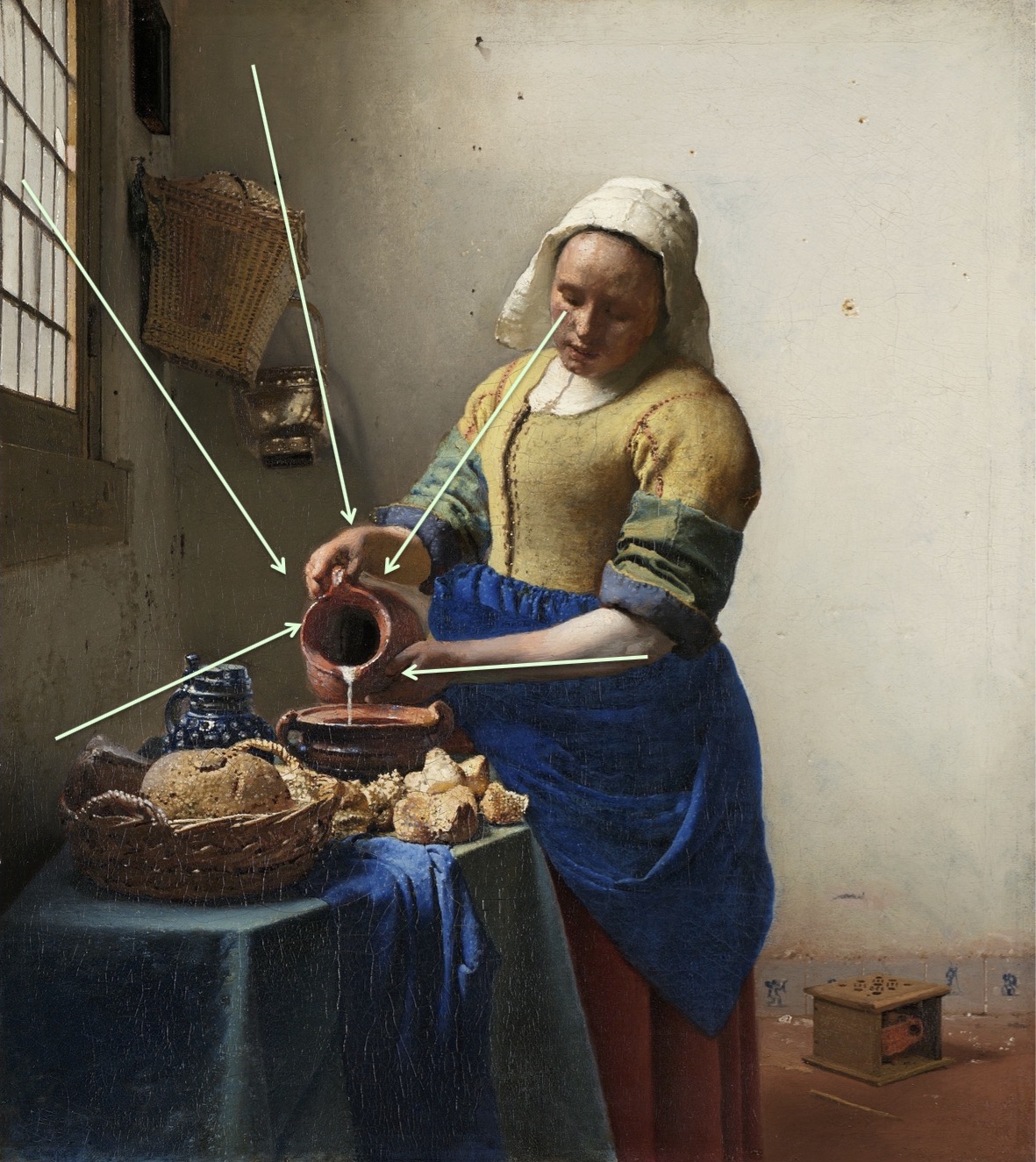
Invisible lines in the painting direct viewers’ attention to the earthenware vessel.
The various tones of the wall in detail.

The tone variation of the wall suggests the three-dimensional figure of the maid.


Analyzing the shape of the table.



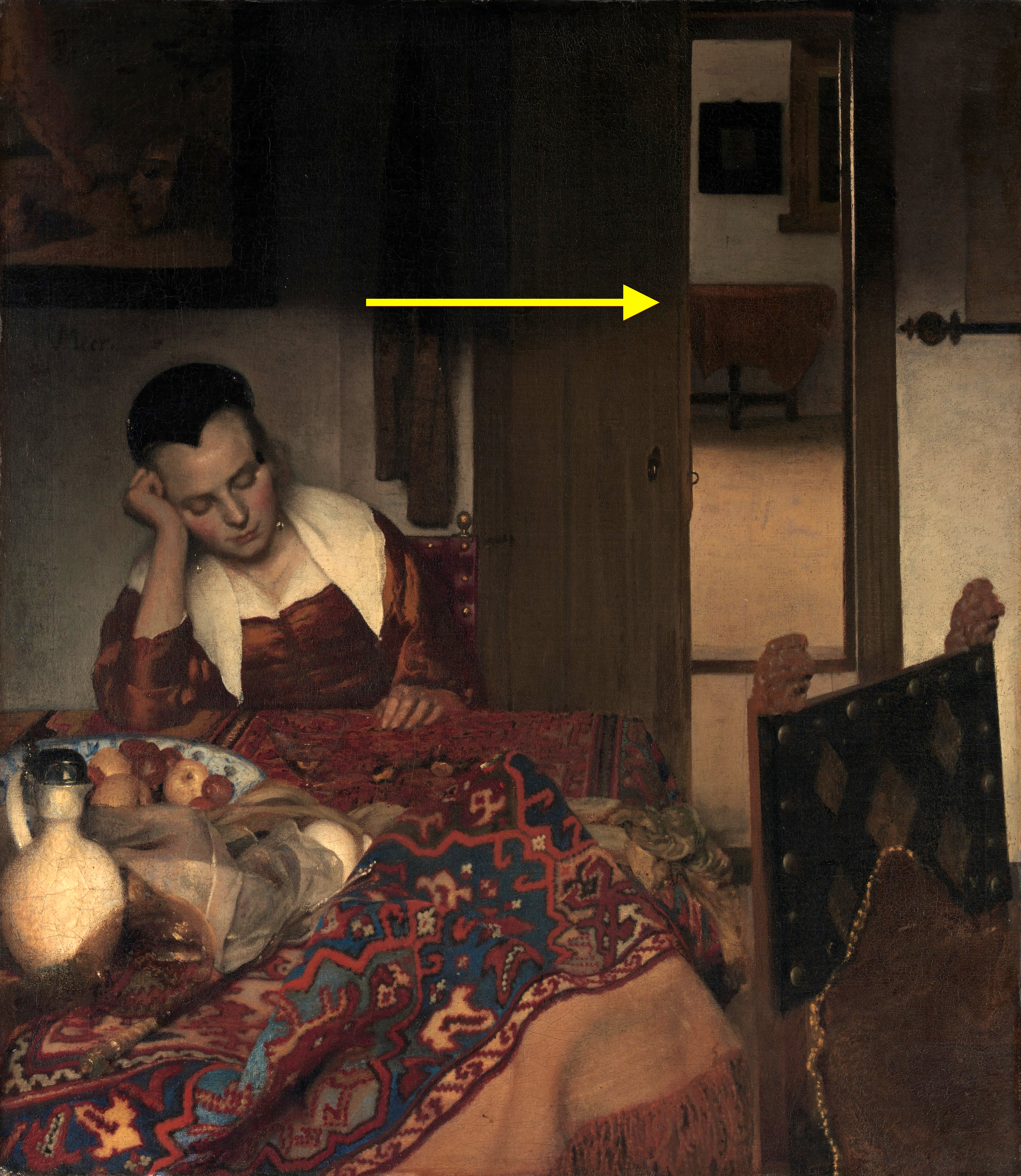
A Girl Asleep, 1657
Johannes Vermeer (1632 - 1675)
Oil on canvas
87.6 × 76.5 cm
Metropolitan Museum of Art, New York
Context Question
Introduction
- Context questions concern about when, where, who, history, the present, the exhibition environment, etc.
- Inquire about the tradition (context of creation) and the location (institutional context in which the artwork is situated) of the artwork.
- Introduce biographical and contextual knowledge of the artwork.
- Lead students to realise that their understanding of the artwork might not be comprehensive.
- Learn about the background against how the artwork was created, exhibited and appreciated.
Examples
- Can we identify the country in which the artwork was produced from the clothes and the surrounding environment of the woman? Can the work reflect the social milieu of the country?
- Who made this artwork? How much do you know about the artist?
- How about the politics, culture, religion and traditions prevailing in the country at the time?
- Who do you think the artwork was made for? Why?
- In what way is the artwork influenced by the artistic tradition?
The ways maids were dressed at the time.



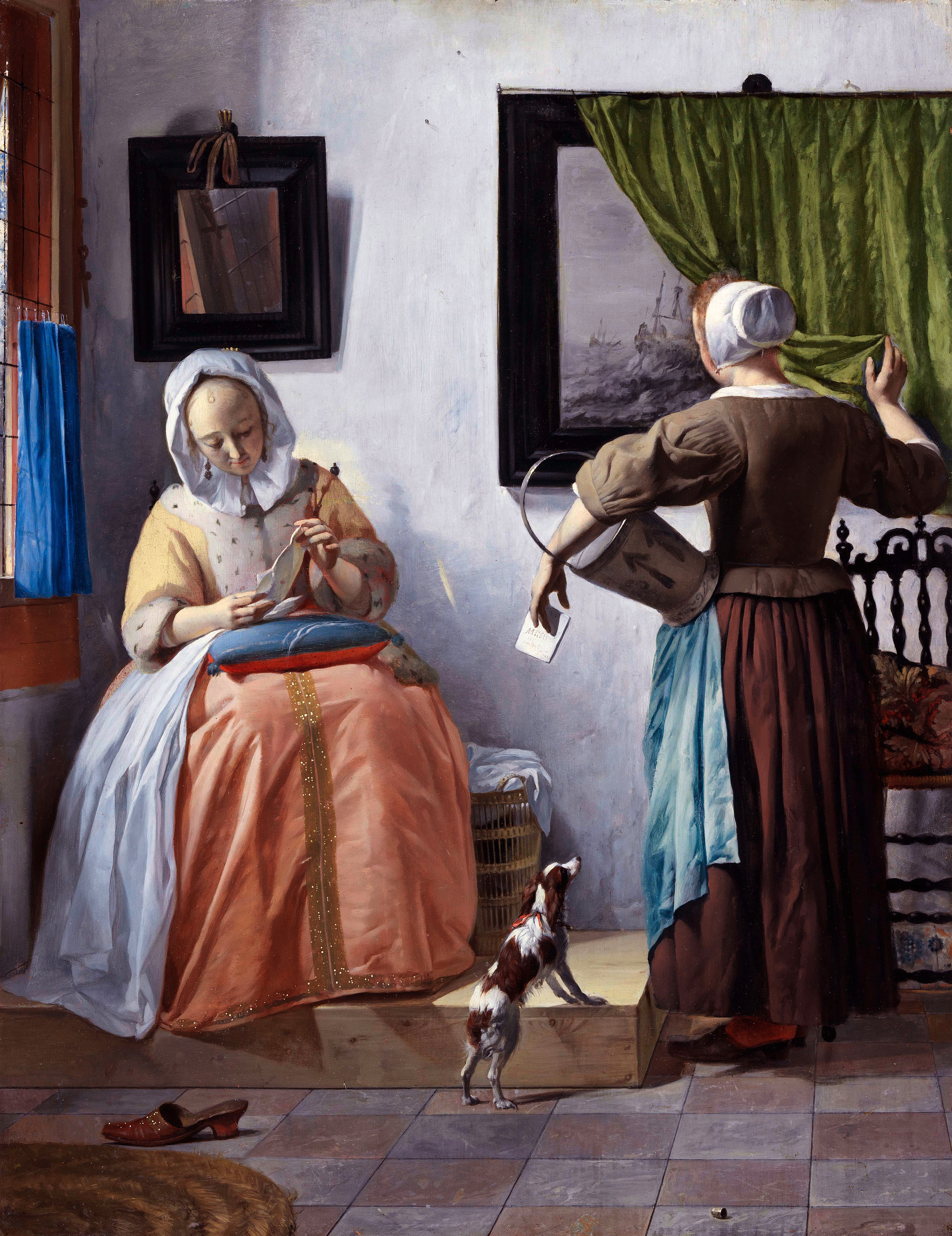
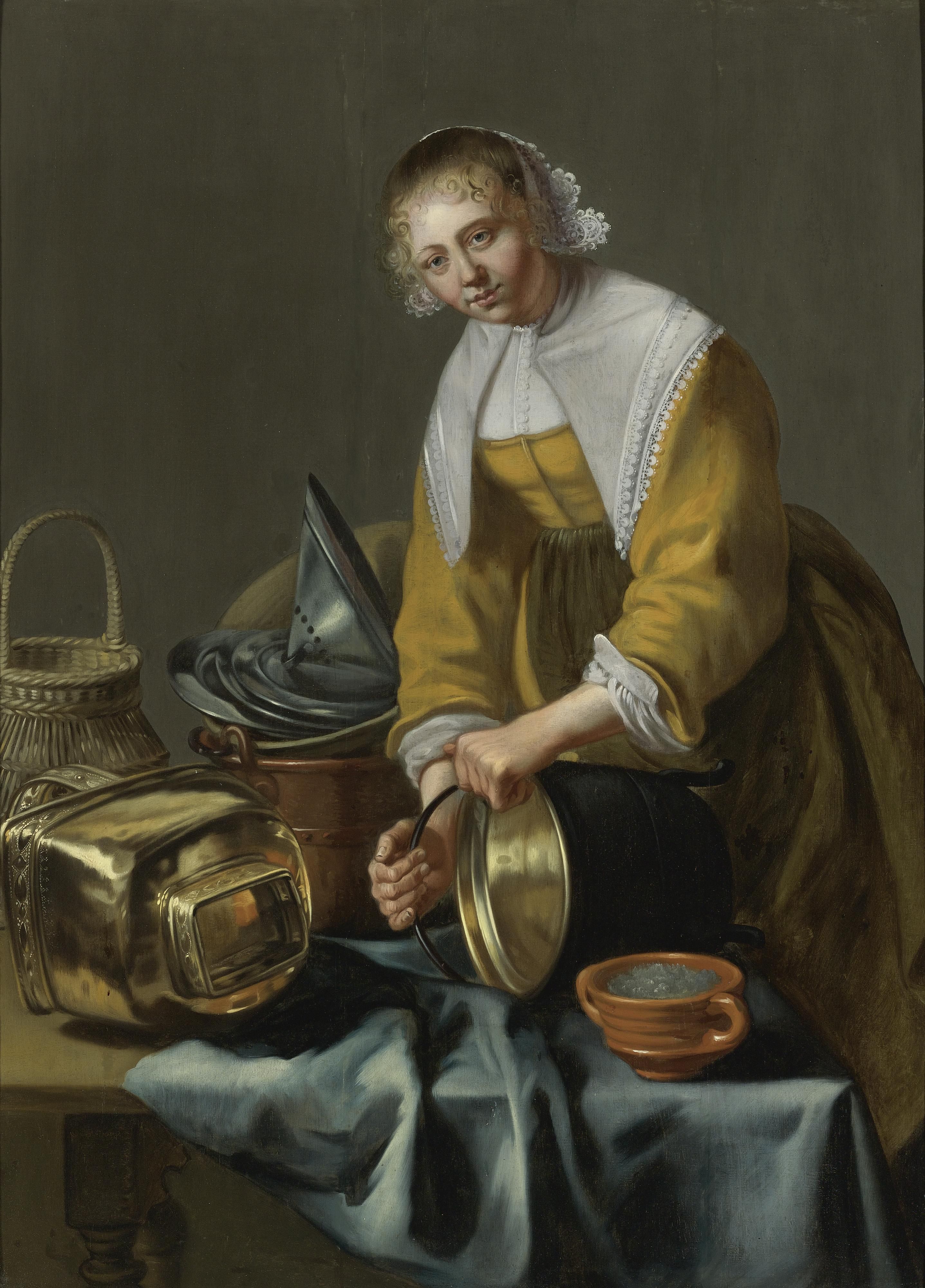
A Kitchen Maid Standing by a Table With Copper Pots Pewter Plates and Other Objects, 1638
Willem van Odekercken (1610-1677)
Oil on panel
104.1 x 76.1 cm
Private collection
Growing environment of Vermeer.

View of Delft, c. 1660 - 1661
Johannes Vermeer (1632 - 1675)
Oil on canvas
96.5 x 115.7 cm
Mauritshuis, The Hague

Contemporary view of Delft

Figures in a Courtyard behind a House, c. 1663 - 1665
Pieter de Hooch (1629 - 1684)
Oil on canvas
60 x 45.7 cm
Rijksmuseum, Amsterdam

View of the Westerkerk, Amsterdam, c. 1667 - c. 1670
Jan van der Heyden (1637–1712)
Oil on panel
53.3 cm x 64.1 cm
Museum of Fine Arts, Boston
To acquire a deeper understanding of the artist, watch the film “Girl with a Pearl Earring” inspired by the life story of Vermeer.




“Tim's Vermeer” is a documentary centred on the attempts to recreate Vermeer’s works.




Traditional kitchen design and interior structure in the Netherlands, and the probable exterior appearance of the window depicted in Vermeer’s painting.




Many traditional architectural styles are preserved in the Netherlands.

The Little Street, c. 1658
Johannes Vermeer (1632 - 1675)
Oil on canvas
54.3 x 44 cm
Rijksmuseum, Amsterdam
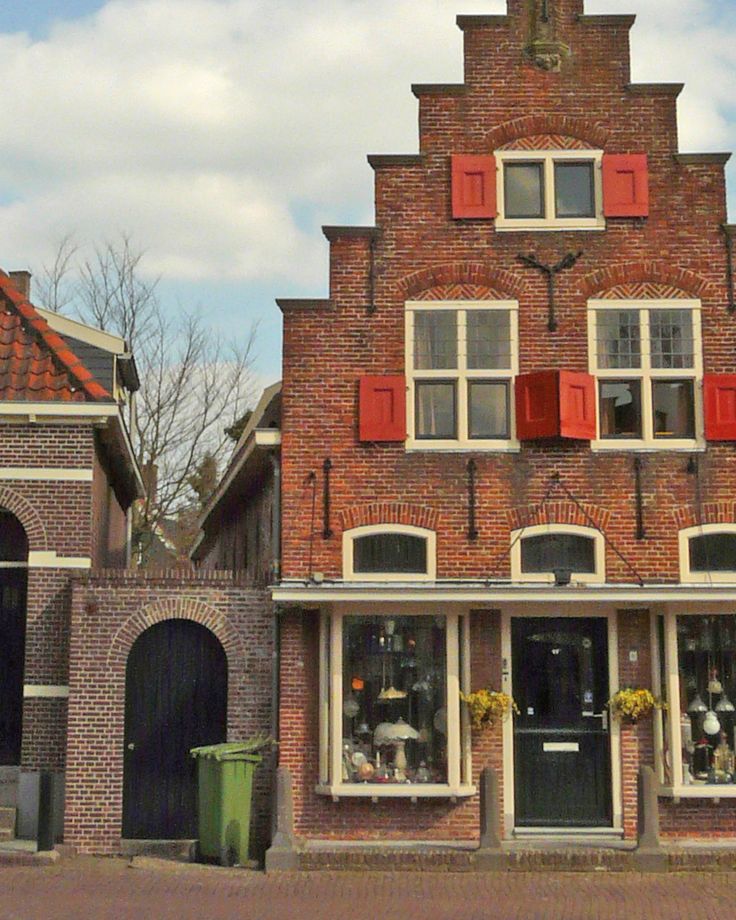
A contemporary photo
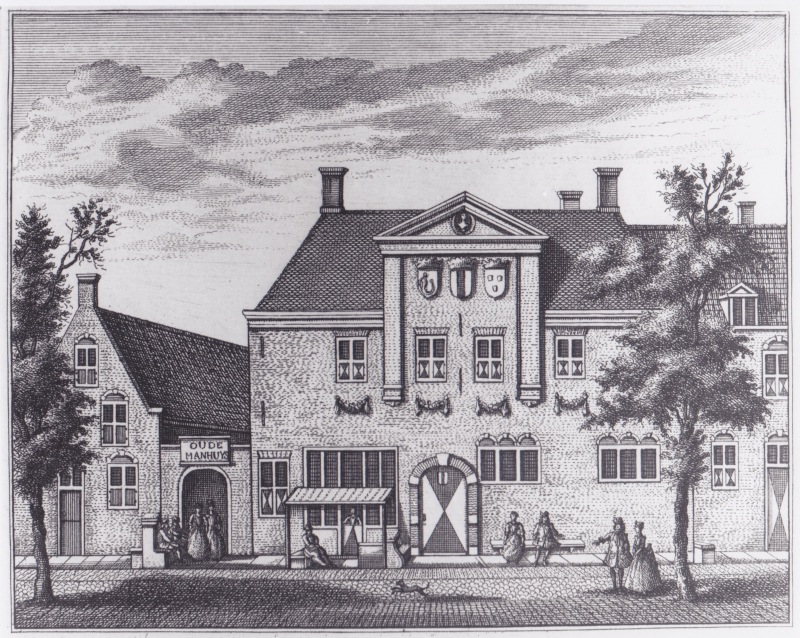
Engraving by Leonard Schenk c.1732, from drawing by Abraham Rademaker of the Guildhall of Saint Luke on the Voldersgracht, c.1700.
Interpretation Question
Introduction
- Draw attention to the meanings, values, subject matter, messages and mood of an artwork.
- Recognize the diversity of the social and cultural context in which an artwork is produced. Different kinds of symbols, metaphors, structures and artistic meanings should be interpreted in specific context in order to get full understanding an artwork.
- Elicit viewers’ associations and emotions.
- Good interpretation is usually based on reasonable justifications and evidence, which is therefore convincing, inspiring and well-informed.
Examples
- Can you describe the maid’s movement, facial expression and attitude when pouring the milk? Can we tell the personality of the maid? Why does she take such great care in pouring the milk?
- Do you find that the maid has a sturdy figure and strong arms? Why is she depicted in this way? Why not render the maid in a slender figure?
- What do you think about the representation of the maid (according to her gesture and facial expression)?
- Why did the painter depict the maid performing her domestic chores? What does the artist want to communicate through his work?
- Do you find anything symbolic?
How is the woman represented in the artworks?

A Woman with a Basket of Beans in a Garden, 1651
Pieter de Hooch (1629 - 1684)
Oil on canvas
69.5 × 59 cm
Kunstmuseum, Basel

A Woman Spinning, 1655
Nicolaes Maes (1634 – 1693)
Oil on panel
41.5 x 33.5 cm
Rijksmuseumm, Amsterdam

The Courtyard of a House in Delft, 1658
Pieter de Hooch (1629 - 1684)
Oil on canvas
73.5 cm × 60 cm
National Gallery, London

The Sick Child, c. 1660-1665
Gabriël Metsu (1629 – 1667)
Oil on canvas
32.2 x 27.2 cm
Rijksmuseum, Amsterdam
What is the symbolic meaning of the water bottle?

Matigheid, c. 1591 - 1595
Jacob de Gheyn II (c. 1565 - 1629)
Paper
D 15 cm

Queen Artemisia, c. 1645
Domenico Fiasella (1589 - 1669)
Oil on canvas
101.2 x 76.1 cm

Temperance, 1683
Painted wood
Commana Parish close, France

Temperantia, 1684 - 1686
Luca Giordano (1634 - 1705)
Fresco
Palazzo Medici, Florence

Temperance
Saint Mary's Church, Chilham
What is the symbolic meaning of the foot warmer?
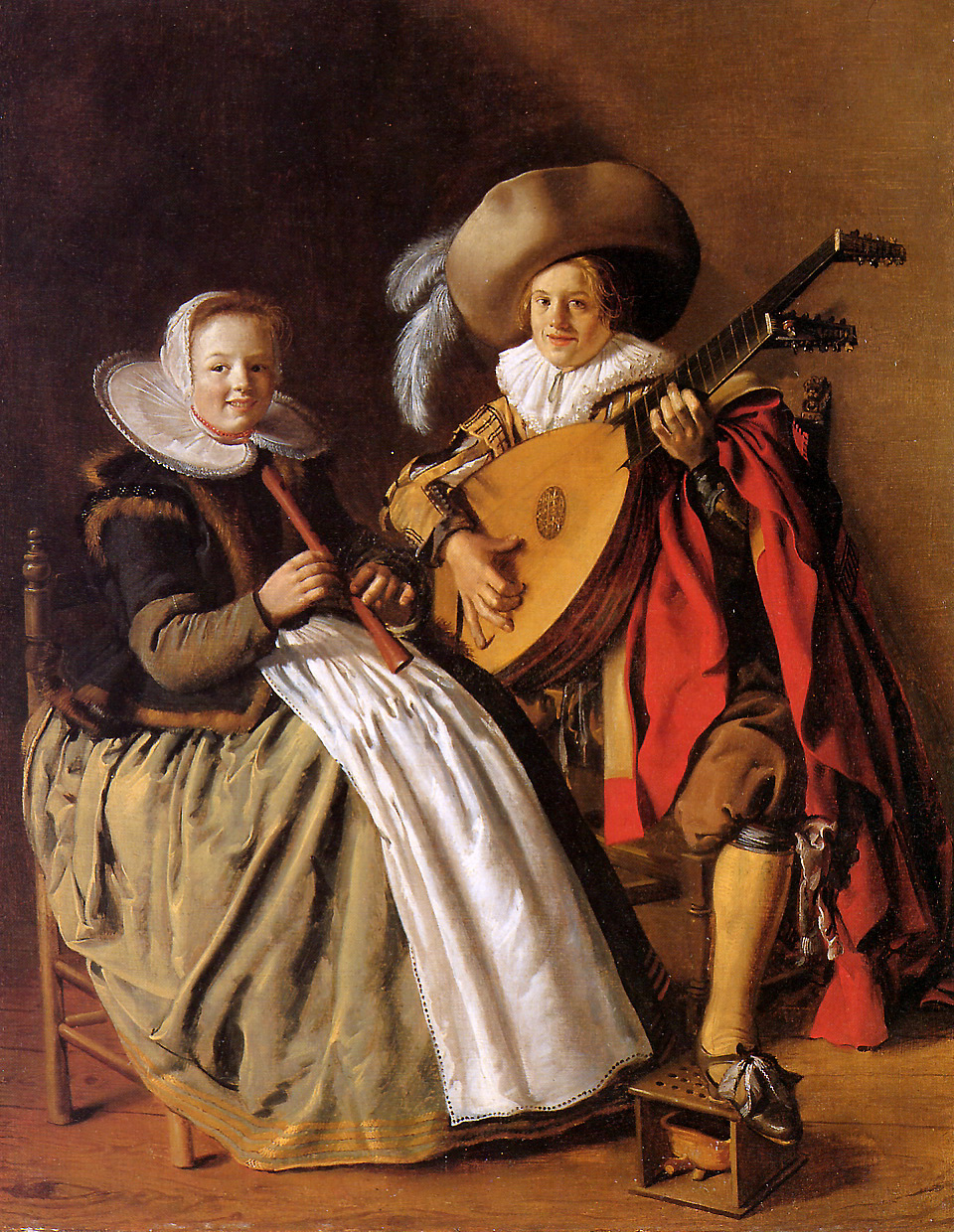
The Duet, c. 1630
Jan Miense Molenaer (c. 1610 – 1668)
Oil on canvas
64.1 x 50.5 cm
Seattle Art Museum, Seattle, Washington, D.C.
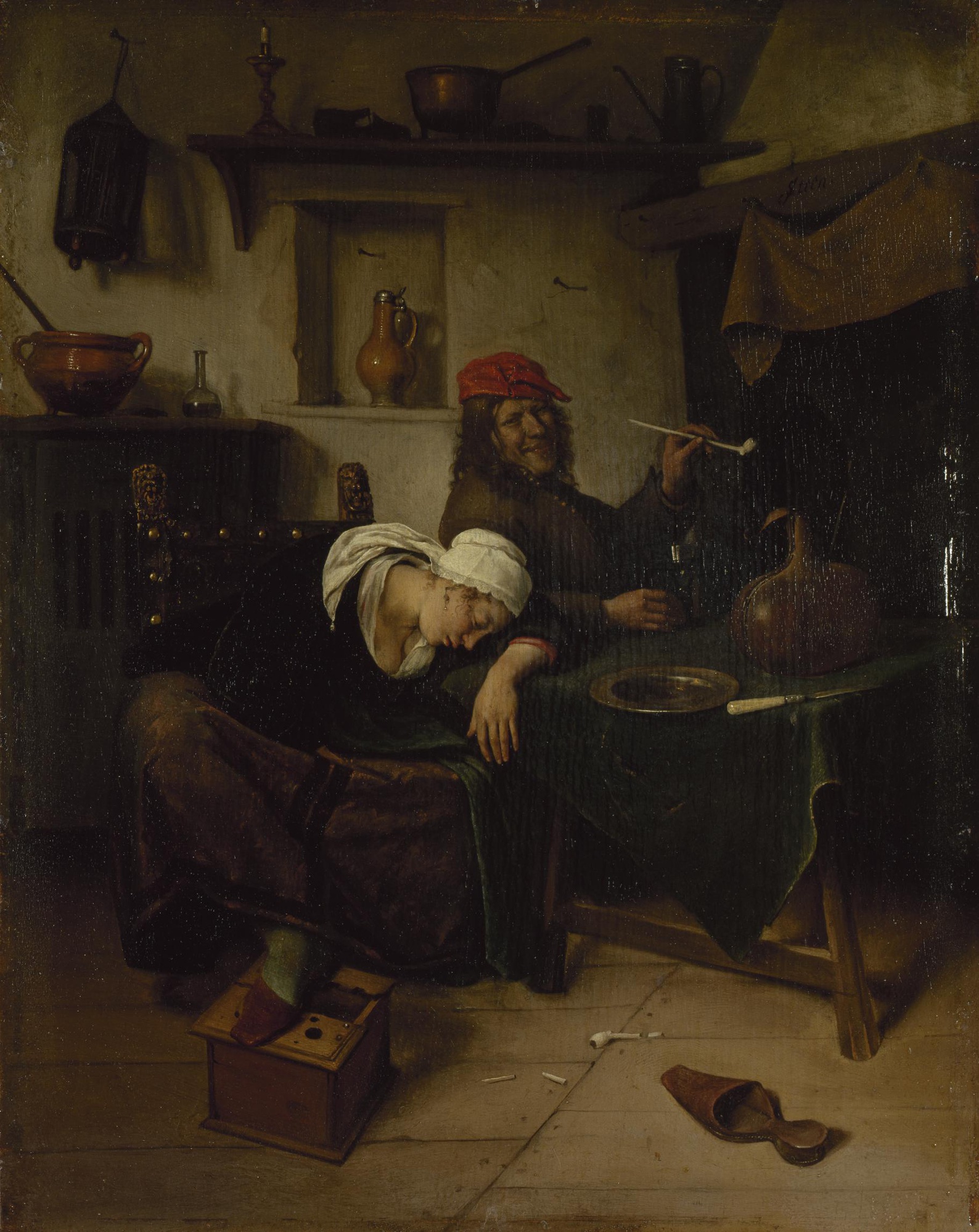
Idlers, c. 1660
Jan Steen (c. 1625 - 1679)
Oil on panel
39 x 30 cm
State Hermitage Museum, Saint Petersburg
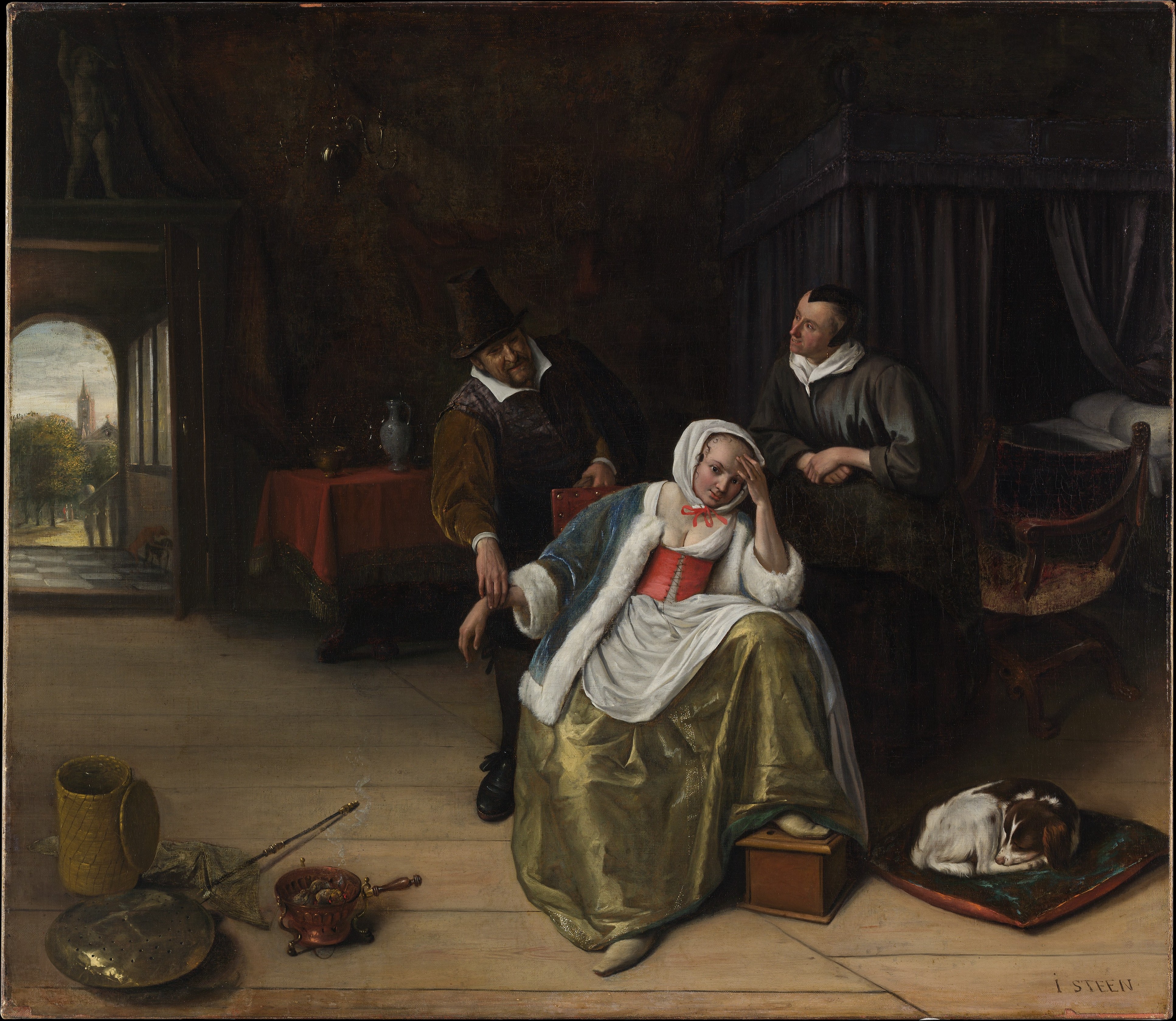
The Lovesick Maiden, c.1660
Jan Steen (c. 1626 – 1679)
Oil on canvas
86.4 x 99.1 cm
Metropolitan Museum of Art, New York

As the Old Sing, So Pipe the Young, c. 1668 - 1670
Jan Steen (c. 1626 - 1679)
Oil on canvas
133.7 x 162.5 cm
Mauritshuis, The Hague
What is the symbolic meaning of the cupid images on the tiles?



What kind of female image is represented in the artworks with maids or woman working in the kitchen?

Kitchen Scene, 1620s
Peter Wtewael (1596–1660)
Oil on canvas
113.7 x 160 cm
Metropolitan Museum of Art, New York

The Kitchen Maid, c. 1620 - c. 1625
Joachim Wtewael (1566–1638)
Oil on canvas
103.2 x 72.3 cm
Centraal Museum, Utrecht

A Girl Chopping Onions, 1646
Gerrit Dou (1613 - 1675)
Oil on panel
20.8 x 16.9 cm
Royal Collection Trust

The Beautiful Kitchen Maid, c. 1735
François Boucher (1703 – 1770)
Oil on wood
55.5 x 43.2 cm
Cognacq-Jay Museum, Paris
Judgment Question
Introduction
- Make critical responses to the values and critical judgment of an artwork.
- Compare similar artworks in order to make value judgement.
- Summarize viewers’ experience and explain how the judgment is made.
Examples
- Do you like / dislike the artwork? Why?
- In what way do you find the artwork attractive / unattractive?
- Do you think the artwork is a masterpiece? In what way?
- Do you have any insights when comparing the artwork with other works?
Some artworks about female characters.

The Man is at Sea (after Demont-Breton), 1889
Vincent van Gogh (1853 - 1890)
Oil on canvas
66 x 51 cm
Private Collection

Woman with a Flower, 1932
Pablo Picasso (1881 - 1973)
Oil on canvas
162 x 130 cm
Kunstmuseum Basel, Basel

Woman with a Head of Roses, 1935
Salvador Dali (1939 - 1989)
Oil on wood panel
35 x 27 cm
Kunsthaus Zürich, Zürich

Untitled #225, 1990
Cindy Sherman (1954-)
Chromogenic color print
121.92 x 83.82 cm
Food packages inspired by The Milkmaid.


During the outbreak of COVID-19, the Rijksmuseum invites netizens to re-enact famous paintings at home, resulting in some creative re-creations.


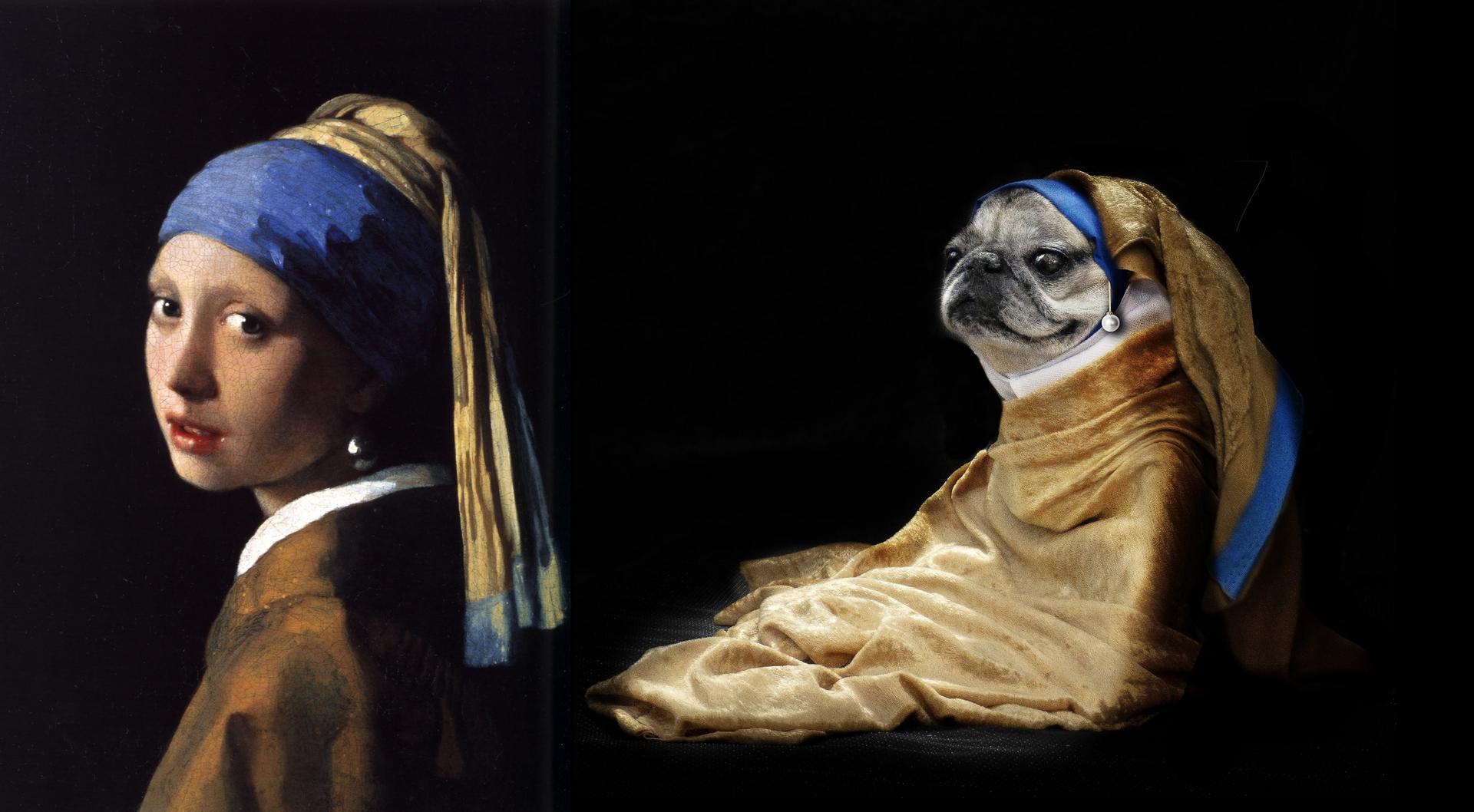
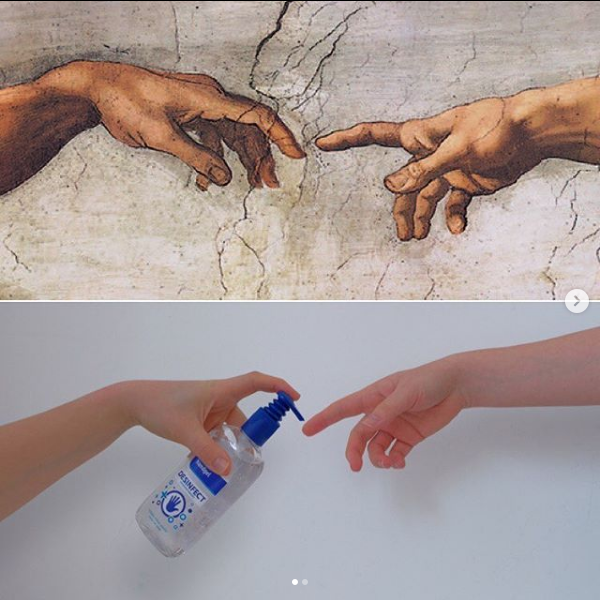
In collaboration with a toy company, the museum has launched a figure set inspired by The Milkmaid.


